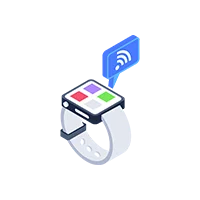AR stands for Augmented Reality, which is an interactive experience where computer-generated objects or graphics are overlaid in the real world. AR can be used in various industries, including retail, education, healthcare, and entertainment. For businesses, AR technology provides a new way to engage with customers and improve their experiences.
One example of how AR can help in business growth is through the use of virtual try-on technology. For instance, clothing retailers can allow customers to see how a particular outfit would look on them using an AR-powered virtual mirror. This helps customers make more informed purchase decisions, leading to increased sales and customer satisfaction.
Another example is the use of AR in product demonstrations or training. Companies can use AR to create interactive simulations to train employees on new products or services. This can lead to improved efficiency and productivity, as well as increased customer satisfaction due to better-trained staff.
Overall, Augmented Reality trends in 2023 can help businesses grow by enhancing customer experiences, improving employee training, and driving sales.
Augmented Reality Trend in 2023
There are many possible trends that might excite you but here we have listed 8 important and business-friendly AR trends that will give your business an edge over others.
1. AR integration with 5G technology
With the rollout of 5G technology, Augmented Reality for business experiences can become even more seamless and immersive. This can lead to the development of more sophisticated AR applications, including AR-enabled remote collaboration and communication tools.
5G networks can provide much higher data transfer rates, enabling AR applications to deliver high-quality, real-time images and videos without any delay. This can be particularly useful in industries such as healthcare and manufacturing, where real-time data transfer is essential for quick decision-making.
5G networks have very low latency, which means that AR applications can deliver real-time information and instructions to users without any lag. This can be particularly useful in scenarios where users need to make quick decisions based on real-time information, such as in emergency response situations. There are only a few Augmented Reality app development companies that provide this service.
2. AR in automotive and transportation
AR technology can be used to enhance driver safety, provide real-time navigation, and improve the overall driving experience. For instance, AR displays can project useful information like speed limits, traffic conditions, and directions onto the windshield.
AR can be used to provide real-time information and guidance to mechanics and technicians during maintenance and repair tasks. For example, AR glasses can be used to overlay information about a vehicle’s components and systems onto the mechanic’s field of vision, making it easier to identify and diagnose problems.
Augmented Reality trends can be used to provide drivers with real-time navigation information and directions overlaid with the physical environment. This can be particularly useful in situations where drivers need to navigate complex routes or unfamiliar areas. AR can also be used to provide information about road conditions, weather, and traffic patterns, allowing drivers to make better decisions while on the road.
3. AR for customer service
Businesses can use AR technology to provide virtual assistance and support to customers. This can include virtual product demonstrations, step-by-step guides, and troubleshooting assistance.
AR can be used to provide virtual product demonstrations to customers, allowing them to see and interact with products in real-time without having to physically visit a store. This can be particularly useful for complex or expensive products, where customers may have questions or concerns before making a purchase.
Top AR companies provide this facility to their customers with real-time information about products and services, such as pricing, availability, and features. This can be particularly useful for customers who are in a hurry or who may not have access to a sales representative. You need AR developers to get this facility in your application.
4. AR in architecture and real estate
AR can be used to create immersive 3D models and visualizations of buildings and structures. This can help architects and real estate professionals better communicate their designs to clients and stakeholders.
AR can be used to create virtual 3D models of buildings and spaces, allowing clients to see and interact with designs in real-time. This can be particularly useful for visualizing complex architectural designs or for showing clients what a space will look like once it’s built.
AR can be used to facilitate collaboration between architects, designers, and clients, allowing for real-time feedback and adjustments to designs. This can help to streamline the design process and ensure that clients are happy with the final product.
5. AR is used alongside Metaverse
In the Metaverse, users can create and customize their avatars to represent themselves in the virtual world. AR technology can be used to create augmented reality avatars that users can see and interact with in the physical world, allowing for a more seamless transition between the two.
Users in the Metaverse can interact with virtual objects in the virtual world. AR technology can be used to allow users to interact with virtual objects in the physical world as well, creating a more immersive experience. For example, users could use AR glasses to place virtual furniture in their physical environment and see how it looks before purchasing it.
6. Augmented Reality and Artificial Intelligence work together
AI can be used to analyze customer data and preferences to create personalized marketing campaigns. AR can then be used to overlay targeted advertising content onto the physical environment, creating a more engaging and memorable experience for the customer.
AI-powered chatbots can be integrated with AR technology to create a more personalized and engaging customer support experience. AR can be used to provide visual aids and step-by-step instructions to help customers troubleshoot issues in real time.
AR can be used to create immersive training experiences for employees, while AI can be used to provide personalized feedback and support. This can help to accelerate the learning process and improve employee performance, leading to better business outcomes.
7. Augmented Reality Glasses: Future and Fiction
AR glasses are wearable devices that use augmented reality technology solution companies to overlay digital information on top of the physical world, allowing users to see and interact with virtual objects as if they were part of the real world.
Meta’s headset Cambria is an example of an AR headset that uses this technology. It is a wearable headset that allows users to see virtual objects and information overlaid in the real world. The headset uses sensors and cameras to track the user’s movements and position in the physical environment and then overlays digital information onto the user’s field of vision.
Cambria is designed for enterprise use and is intended to help workers in fields such as manufacturing, construction, and healthcare. It can be used to provide real-time information and instructions to workers, and can also be used for training and simulation purposes.
The post Grow your business with these Augmented Reality Trends in 2023 appeared first on .
Tags:
- AR-VR Application Development
- Software Development Company
- ar trends
- augmented reality for business
- augmented reality technology solution companies
- augmented reality trend
- augmented reality trends 2023

 .NET MAUI Development
.NET MAUI Development
 Xamarin Application Development
Xamarin Application Development
 React Native App Development
React Native App Development
 iOS Application Development
iOS Application Development
 Android Application Development
Android Application Development
 Android Wear App Development
Android Wear App Development
 Ionic Development
Ionic Development
 iBeacon Application Development
iBeacon Application Development
 Universal Windows Platform (UWP)
Universal Windows Platform (UWP)
 Kotlin Application Development
Kotlin Application Development
 Swift Application Development
Swift Application Development
 Flutter Application Development
Flutter Application Development
 PWA Application Development
PWA Application Development
 Offshore Software Development
Offshore Software Development
 Custom Application Development
Custom Application Development
 Front-End Development
Front-End Development
 Full Stack Development
Full Stack Development
 AI & Machine Learning
AI & Machine Learning
 Custom CRM Solutions
Custom CRM Solutions
 Flask Software Development
Flask Software Development
 Electron JS Development
Electron JS Development
 ChatGPT Development
ChatGPT Development
Telemedicine App Development
Build Smart Telemedicine Platform
Beauty & Salon App Solutions
Hire Workato Experts
Workato Consulting & Support
 .NET Application Development
.NET Application Development
 .NET Nuke Development
.NET Nuke Development
 Microsoft Dynamics CRM
Microsoft Dynamics CRM
 Microsoft Small Business Solution
Microsoft Small Business Solution
 VB .NET Development
VB .NET Development
 C# Development
C# Development
 Sharepoint Migration
Sharepoint Migration
 Sharepoint Development
Sharepoint Development
 ASP.NET Core Development
ASP.NET Core Development
 ASP.NET Development
ASP.NET Development
 ASP.NET MVC Development
ASP.NET MVC Development
 Kentico CMS
Kentico CMS
 Umbraco CMS
Umbraco CMS
 AJAX Development
AJAX Development
 Agile Development
Agile Development
 Microsoft Bot
Microsoft Bot
 Microsoft Blazor
Microsoft Blazor
 Microsoft Azure Cognitive
Microsoft Azure Cognitive

 Mean Stack Development
Mean Stack Development
 Vue JS Development
Vue JS Development
 Javascript Development
Javascript Development
 Angular JS Development
Angular JS Development
 Next JS development
Next JS development
 Java Development
Java Development
 Python Development
Python Development
 Django Development
Django Development
 Cherrypy Development
Cherrypy Development
 NodeJS Development
NodeJS Development
 Laravel Development
Laravel Development
 CodeIgniter Development
CodeIgniter Development
 Zend Development
Zend Development
 Ruby on Rails Development
Ruby on Rails Development
 CakePHP Development
CakePHP Development
 PHP Website Development
PHP Website Development
 Symfony Development
Symfony Development
 Drupal Development
Drupal Development
 Joomla Development
Joomla Development
 Wordpress Development
Wordpress Development
 Magento Development
Magento Development
 Magento 2.0 Development
Magento 2.0 Development
 Magento Enterprise
Magento Enterprise
 Shopping Cart Development
Shopping Cart Development
 Prestashop Development
Prestashop Development
 Shopify Development
Shopify Development
 Open Cart Development
Open Cart Development
 WooCommerce Development
WooCommerce Development
 BigCommerce Development
BigCommerce Development
 NopCommerce Development
NopCommerce Development
 Virto Commerce Development
Virto Commerce Development
 AspDotNetStorefront Development
AspDotNetStorefront Development
 RaspBerry Pi
RaspBerry Pi
 Firmware Software Development
Firmware Software Development
 ESP 32 Software Development
ESP 32 Software Development
 Embedded Development
Embedded Development
 Internet of Things
Internet of Things
 Nordic Development
Nordic Development
 HTML 5
HTML 5
 UI/UX Design
UI/UX Design
 Graphic Design
Graphic Design
 Adobe Photoshop
Adobe Photoshop
 XML Application Development
XML Application Development
 Cloud Computing Solutions
Cloud Computing Solutions
 Azure Cloud App Development
Azure Cloud App Development
 AWS Development
AWS Development
 Google Cloud Development
Google Cloud Development
 SQL Programming Development
SQL Programming Development
 MySQL Development
MySQL Development
 MongoDB Development
MongoDB Development
 Big Data
Big Data
 Robotic Process Automation
Robotic Process Automation
 Social Media Marketing
Social Media Marketing
 Search Engine Optimization
Search Engine Optimization
 QA Testing
QA Testing
 Software Testing
Software Testing
 Software Security
Software Security
 Maintenance And Support
Maintenance And Support
 I.T. Consulting Services
I.T. Consulting Services
 Business Intelligence
Business Intelligence
 YII Development
YII Development
 Data Analysis
Data Analysis
 Alexa Skills Development
Alexa Skills Development
 On Demand App for Mobile repairing services
On Demand App for Mobile repairing services
 On Demand App for Car Service Booking
On Demand App for Car Service Booking
 On Demand App for Cleaning Services
On Demand App for Cleaning Services
 On Demand App for Pharmacy
On Demand App for Pharmacy
 On Demand Dedicated Developers
On Demand Dedicated Developers






Leave a Reply